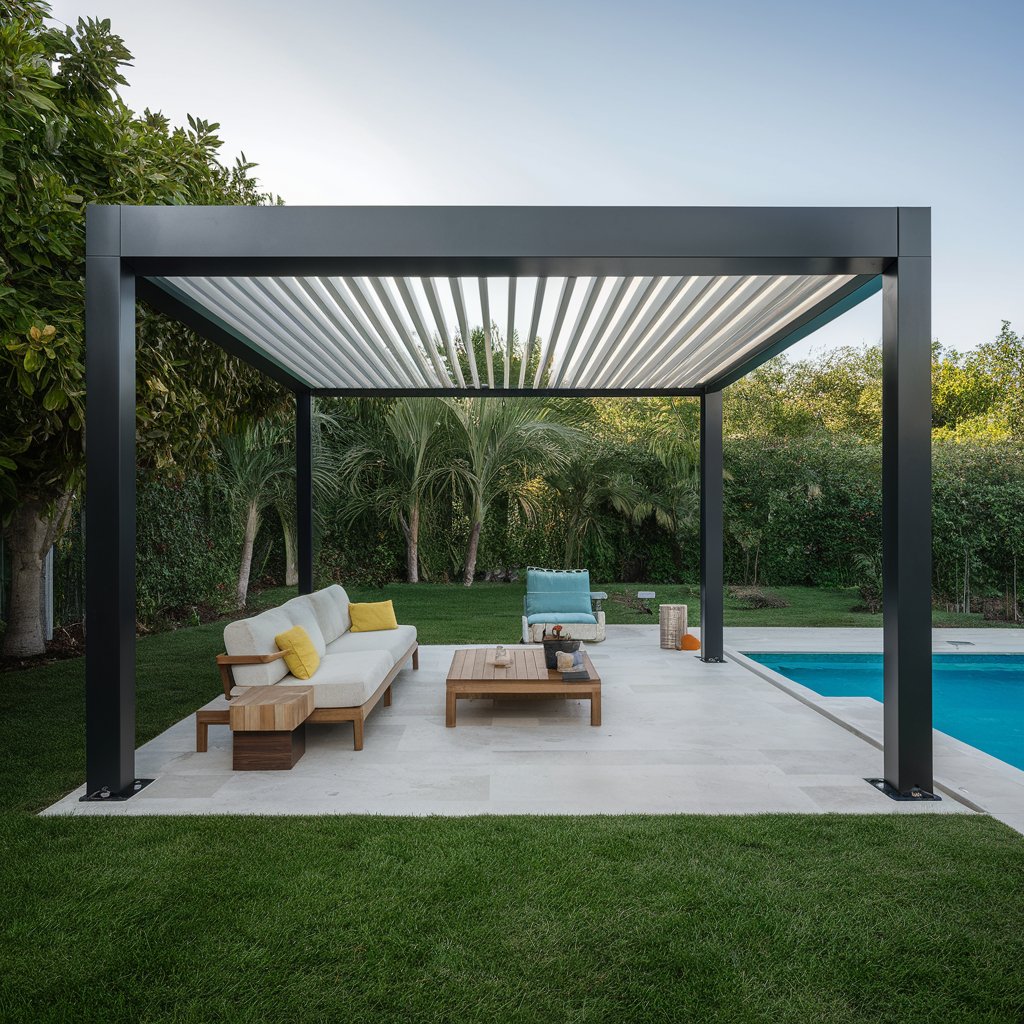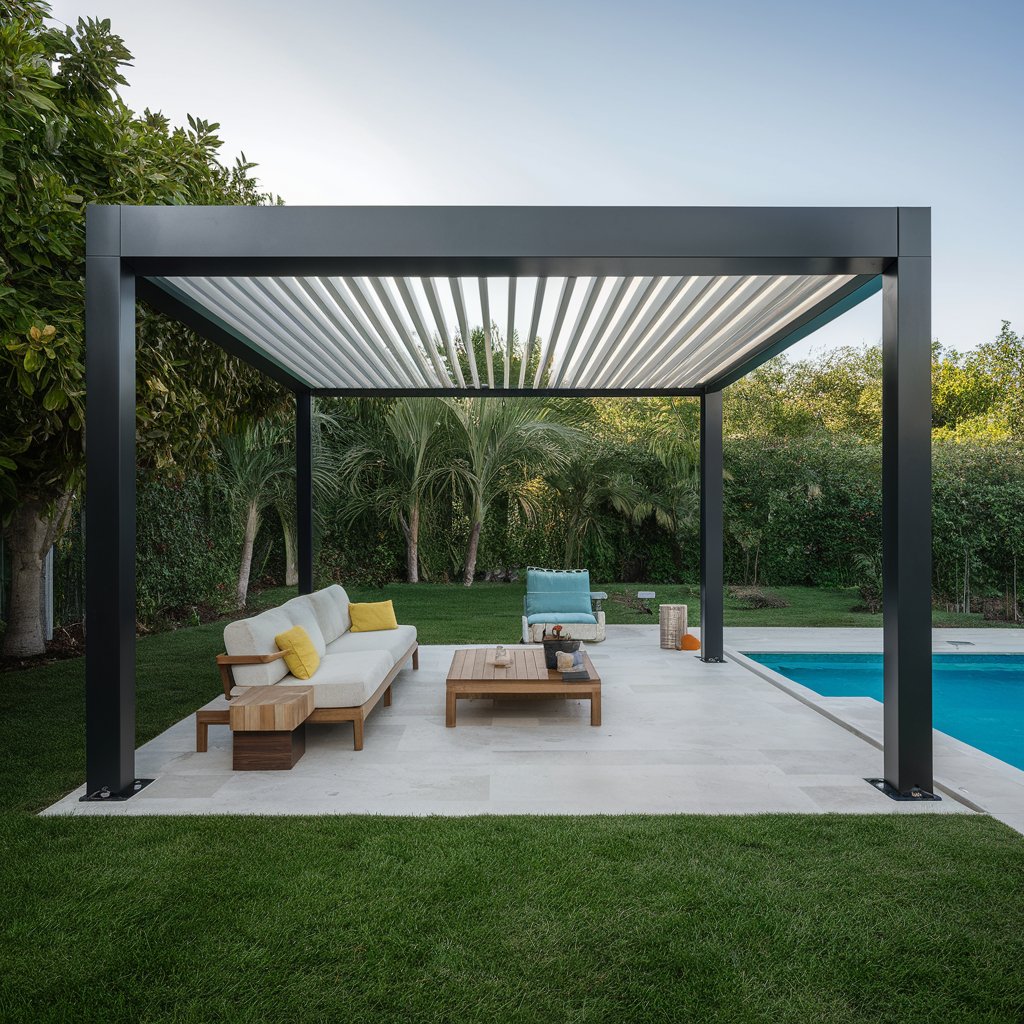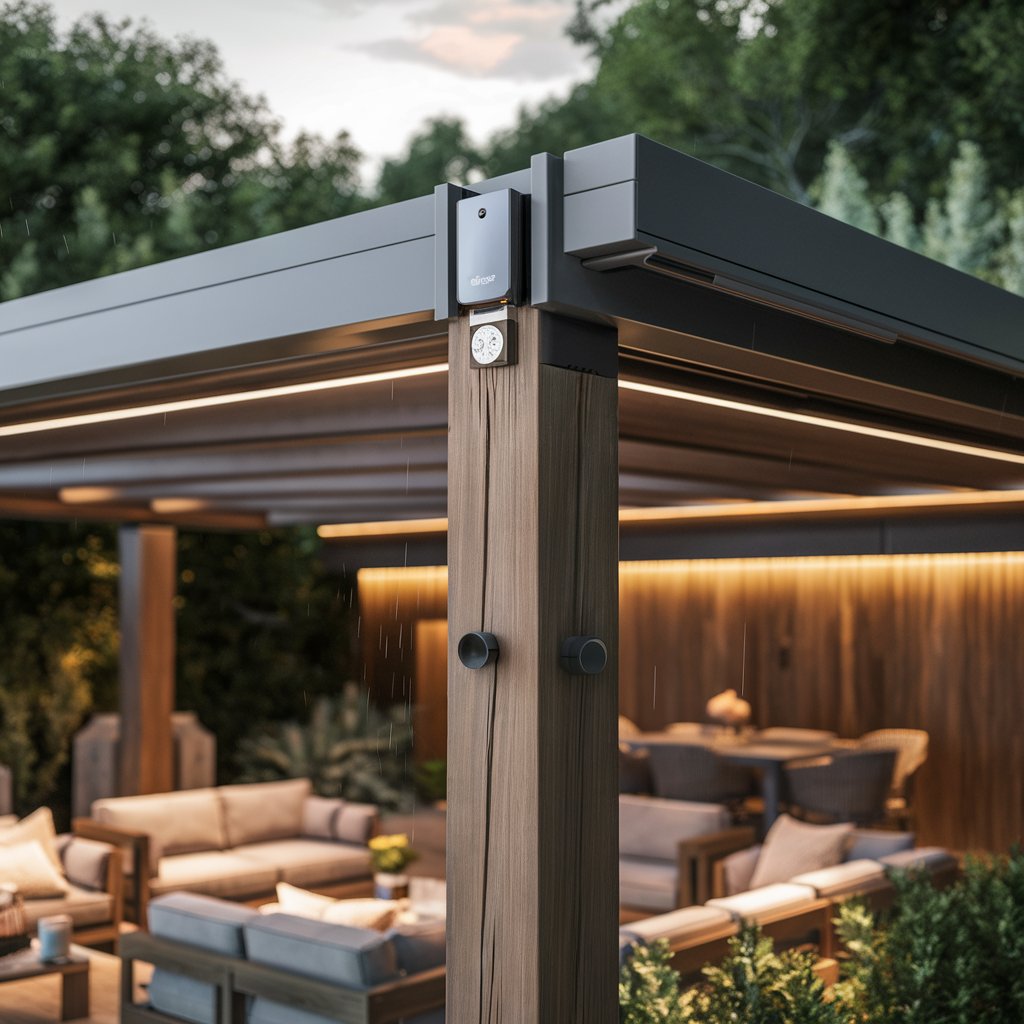Introduction
Pergolas have long been a beloved feature in gardens and outdoor spaces, providing both aesthetic beauty and functional space for relaxation and social gatherings. Rooted in ancient architecture, the modern American pergola has evolved to encompass a range of styles, materials, and uses, making it a versatile addition to any backyard or garden. This article explores the history, design, materials, and benefits of pergolas, focusing particularly on their unique place in American culture.

History of American Pergolas
Ancient Beginnings
The concept of the pergola dates back to ancient times, with early examples found in Egyptian, Roman, and Greek gardens. These structures were typically made of wood or stone and were used to support climbing plants, creating shaded walkways and intimate garden spaces. Pergolas were often integral to the design of classical gardens, reflecting the architectural styles and cultural values of the time.
Evolution in Europe
During the Renaissance, pergolas saw a resurgence in popularity, particularly in Italy. Italian pergolas were grander and more elaborate, often featuring intricate stone columns and wooden beams. These structures became a symbol of wealth and sophistication, gracing the gardens of the elite and serving as venues for social gatherings and leisurely pursuits.
Arrival in America
Pergolas made their way to America during the colonial period, where they were initially influenced by European designs. However, as American architecture and garden design evolved, pergolas began to take on unique characteristics that reflected the country’s diverse cultural influences and climatic conditions.
Design Elements of American Pergolas
Styles
American pergolas come in a variety of styles, each offering a distinct aesthetic and functional appeal. Some of the most popular styles include:
- Traditional Pergolas: These often feature classic lines and symmetrical designs, reminiscent of early European influences. Traditional pergolas are usually constructed from wood and may include decorative elements such as latticework and intricate carvings.
- Modern Pergolas: Characterized by clean lines and minimalistic design, modern pergolas often incorporate materials like metal and composite wood. These pergolas emphasize functionality and simplicity, blending seamlessly with contemporary architecture.
- Rustic Pergolas: Inspired by natural surroundings, rustic pergolas are typically made from rough-hewn wood or reclaimed materials. They exude a charming, earthy vibe, making them perfect for countryside settings or homes with a rustic aesthetic.
- Mediterranean Pergolas: Drawing from the sunny climates of Southern Europe, Mediterranean pergolas often feature stucco columns, terracotta roofs, and vibrant, colorful accents. These structures are designed to provide ample shade and create a relaxed, inviting atmosphere.
Structural Components
Regardless of style, most pergolas share common structural components:
- Posts: The vertical supports that anchor the pergola to the ground. Posts can be made from wood, metal, or stone, and their size and spacing depend on the overall design and intended use of the pergola.
- Beams and Rafters: The horizontal elements that span the top of the pergola, providing support and structure. Beams and rafters can be arranged in various patterns to create different levels of shade and visual interest.
- Lattice or Trellis: Optional elements that can be added to the sides or top of the pergola to support climbing plants or enhance privacy. Latticework can be simple or elaborate, depending on the desired aesthetic.
- Anchors and Footings: Essential for ensuring the stability and safety of the pergola, especially in areas prone to strong winds or heavy snowfall. Anchors and footings must be properly installed and secured to prevent shifting or collapse.
Materials for American Pergolas
The choice of materials significantly impacts the durability, appearance, and maintenance requirements of a pergola. Common materials used in American pergola construction include:
Wood
Wood is a traditional and popular choice for pergolas, offering natural beauty and versatility. Common types of wood used include:
- Cedar: Known for its resistance to rot and insects, cedar is a durable and aesthetically pleasing option. Its natural color ranges from light amber to rich reddish-brown, and it can be left untreated to develop a silver-gray patina over time.
- Redwood: Similar to cedar in terms of durability and resistance, redwood features a rich, reddish hue and tight grain. It is often chosen for its natural beauty and ability to withstand the elements.
- Pressure-Treated Pine: A more affordable option, pressure-treated pine is chemically treated to resist rot and insects. It can be stained or painted to match the desired aesthetic but requires regular maintenance to prevent warping and cracking.
Metal
Metal pergolas offer a sleek, modern look and are highly durable. Common metals used include:
- Aluminum: Lightweight and resistant to rust, aluminum is a low-maintenance option that can be powder-coated in various colors. It is ideal for contemporary designs and coastal areas where saltwater exposure is a concern.
- Steel: Known for its strength and durability, steel can be galvanized or powder-coated to prevent rust. Steel pergolas are often chosen for their industrial aesthetic and ability to support heavy loads.
Vinyl and Composite Materials
Vinyl and composite materials offer a low-maintenance alternative to wood and metal. These materials are resistant to rot, insects, and UV damage, making them a practical choice for long-lasting pergolas. They are available in various colors and styles, mimicking the appearance of wood without the need for regular maintenance.
Benefits of Pergolas
Aesthetic Appeal
One of the primary reasons homeowners choose to install pergolas is their aesthetic appeal. Pergolas can transform an ordinary backyard into a visually stunning outdoor retreat. They add architectural interest and create a focal point in the landscape, enhancing the overall design of the outdoor space.
Functional Space
Pergolas provide a functional outdoor space that can be used for various purposes, such as dining, entertaining, or relaxing. They offer shade and protection from the elements, allowing homeowners to enjoy their outdoor spaces year-round. With the addition of outdoor furniture, lighting, and accessories, a pergola can become an extension of the home’s living area.
Increased Property Value
A well-designed pergola can increase the value of a property by enhancing its curb appeal and providing additional outdoor living space. Pergolas are considered a desirable feature by many homebuyers, making them a worthwhile investment for homeowners looking to improve their property’s resale value.
Support for Plants
Pergolas are ideal for supporting climbing plants, such as vines, roses, and wisteria. These plants can grow up and over the structure, creating a lush, green canopy that provides additional shade and privacy. The combination of a pergola and climbing plants adds a natural, organic element to the landscape, fostering a sense of tranquility and connection to nature.
Customization Options
Pergolas offer a high degree of customization, allowing homeowners to tailor the design to their specific needs and preferences. Options for customization include the choice of materials, size, shape, and additional features such as built-in seating, lighting, and retractable canopies. This flexibility ensures that each pergola is unique and perfectly suited to its intended use and setting.
Building and Installing a Pergola
Planning and Design
Before building a pergola, it is essential to carefully plan and design the structure. Consider the following factors:
- Location: Choose a location that complements the overall landscape design and provides the desired level of shade and privacy. Consider factors such as sun exposure, wind direction, and proximity to the house and other structures.
- Size and Scale: Determine the appropriate size and scale of the pergola based on the available space and intended use. A pergola that is too large or too small can look out of place and fail to provide the desired functionality.
- Permits and Regulations: Check local building codes and regulations to determine if a permit is required for the pergola. Ensure that the design complies with any zoning restrictions or homeowners’ association guidelines.
- Budget: Establish a budget for the project, considering the cost of materials, labor, and any additional features or accessories. A well-defined budget will help guide the design and ensure that the project stays on track financially.
Construction Process
The construction process for a pergola typically involves the following steps:
- Site Preparation: Clear the chosen location of any debris, vegetation, or obstacles. Mark the layout of the pergola using stakes and string to ensure accurate placement of the posts.
- Setting the Posts: Dig holes for the posts, ensuring they are deep enough to provide stability. Set the posts in concrete to prevent shifting and ensure a solid foundation.
- Installing Beams and Rafters: Attach the horizontal beams to the posts, ensuring they are level and securely fastened. Install the rafters across the beams, spacing them evenly to provide the desired amount of shade.
- Adding Optional Elements: If desired, add lattice or trellis panels to the sides or top of the pergola. Install any additional features, such as lighting, seating, or a retractable canopy.
- Finishing Touches: Apply any finishes or treatments to protect the materials and enhance the appearance of the pergola. This may include staining or painting wood, powder-coating metal, or adding decorative elements.
Maintenance and Care
To ensure the longevity and beauty of a pergola, regular maintenance and care are essential. Here are some tips for maintaining a pergola:
Wood Pergolas
- Cleaning: Regularly clean the pergola to remove dirt, debris, and mildew. Use a mild detergent and water, and avoid using harsh chemicals that can damage the wood.
- Staining and Sealing: Periodically stain and seal the wood to protect it from moisture, UV damage, and insects. This will help prevent warping, cracking, and rot.
- Inspecting for Damage: Regularly inspect the pergola for signs of damage, such as cracks, splinters, or insect infestations. Address any issues promptly to prevent further deterioration.
Metal Pergolas
- Cleaning: Clean the metal components with a mild detergent and water, and rinse thoroughly to remove any soap residue.
- Inspecting for Rust: Check for signs of rust or corrosion, particularly in areas where the metal is exposed to moisture. Apply a rust-resistant paint or coating to any affected areas.
- Tightening Hardware: Periodically check and tighten any hardware, such as bolts and screws, to ensure the structural integrity of the pergola.
Vinyl and Composite Pergolas
- Cleaning: Clean the pergola with a mild detergent and water, and rinse thoroughly. Avoid using abrasive cleaners or tools that can scratch the surface.
- Inspecting for Damage: Regularly inspect the pergola for signs of damage, such as cracks or discoloration. Address any issues promptly to maintain the appearance and integrity of the structure.
Enhancing Your Pergola
To make the most of a pergola, consider adding elements that enhance its functionality and aesthetic appeal:
Lighting
Adding lighting to a pergola can extend its usability into the evening hours and create a warm, inviting ambiance. Options for pergola lighting include string lights, lanterns, and integrated LED fixtures. Solar-powered lights are an eco-friendly option that can reduce energy costs.
Furniture and Accessories
Outfit the pergola with comfortable outdoor furniture, such as sofas, chairs, and dining tables. Add cushions, throws, and rugs to create a cozy, inviting space. Consider adding accessories such as outdoor curtains, hanging planters, and decorative lanterns to personalize the pergola and enhance its aesthetic appeal.
Heating and Cooling
Extend the usability of the pergola throughout the year by adding heating and cooling elements. Options include portable heaters, fire pits, and ceiling fans. These additions can help create a comfortable environment, regardless of the weather.
Climbing Plants and Greenery
Incorporate climbing plants and greenery to create a lush, natural canopy and enhance the visual appeal of the pergola. Popular choices for climbing plants include wisteria, clematis, ivy, and climbing roses. Planters and hanging baskets can also be added to bring additional greenery and color to the space.
Conclusion
American pergolas are a timeless and versatile addition to any outdoor space, offering both aesthetic beauty and practical functionality. Whether you prefer a traditional, modern, rustic, or Mediterranean style, there is a pergola design to suit your needs and preferences. By carefully planning and maintaining your pergola, you can create a stunning outdoor retreat that enhances your property and provides a space for relaxation, entertainment, and enjoyment for years to come.


